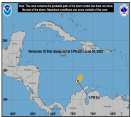Ed Dunham
Former Meteorologist & CFHC Forum Moderator (Ed Passed Away on May 14, 2017)
Reged:
Posts: 2565
Loc: Melbourne, FL
|
|
I’ll start this off with a segment from the original ‘Statistics’ Blog back on August 13, 2006, when the season was running a little slow, when there had been a storm in June, July and August at that time, and when CSU had anticipated a total of 15 named storms for that season:
“I started to wonder what Climatology would think about this season if the next storm this year was not named until after August 25th - and the answers are interesting (if you like numbers). In the past 126 seasons, 74 of them did not have the 4th named storm until after August 25th. Nothing unusual there - seems like a common event, but what do the season totals look like when that happens?
Another interesting answer. The average season total is 8/5/2, with the highest seasons at 14/6/4 (1953) and 13/10/8 (1950). This means that in order for Colorado State (Dr Gray et al) to hit its revised forecast of 15 named storms this season, the next named storm must occur before August 26th...OR...the Atlantic basin must set a new record for season activity after August 25th.â€
So here we are with another close to average starting season playing against an ultra-high seasonal forecast – and with the dialogue that a disparity of those numbers often generates. The problem is not so much in the season itself – so far its about average and it will probably end up that way. It is interesting to note that this year its not just the Atlantic basin that seems a little on the slow side – it’s the entire Northern Hemisphere with limited activity so far in EASTPAC and WESTPAC tropical cyclone areas.
As of August 20th, with regard to calendar days, the season is 44% complete. From the climatological standpoint of the total number of storms (on average) by August 20th vs the total number of storms overall, the season is 42% complete. Splitting the difference infers that there is 57% of the season remaining.
If, at the beginning of the season, your forecast was for 18 named storms this year (similar to the forecasts from CSU, TSR, WSI and NOAA), you now have 57% of the remaining season to achieve 83% of your forecasted total. With a forecast of 14 named storms, you have 57% of what remains of the season to develop about 78% of your storm total. While it is true that these statistics are results compared against an average season, it is also true that the season seldom extends beyond November 30th.
For reference purposes the 2006 season ended up at 9/4/2.
ED
|
|




 Threaded
Threaded



